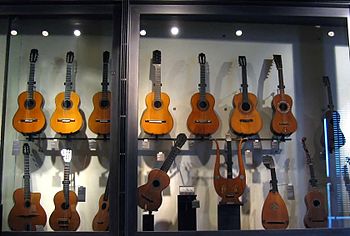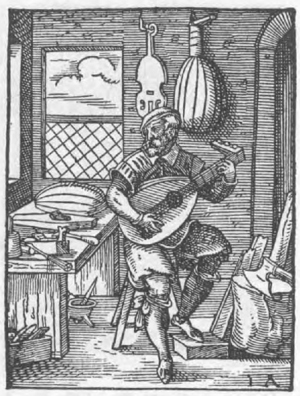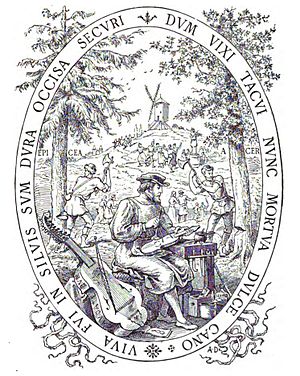- Classical guitar making
-
A person who is specialized in the making of stringed instruments such as guitars, lutes and violins is called a luthier.
Skills
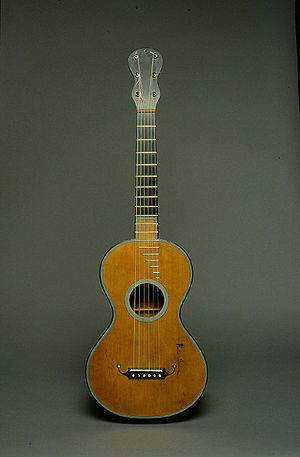 Early romantic guitar (Paris around 1830) by Jean-Nicolas Grobert (1794-1869).
Early romantic guitar (Paris around 1830) by Jean-Nicolas Grobert (1794-1869).
*String scale-length: 635 mm.
Instrument top shows signatures of Paganini and Berlioz. The guitar was loaned to Paganini by Jean-Baptiste Vuillaume in 1838 and later given by Vuillaume to Berlioz,[1] who later donated it to the Musée du Conservatoire de musique in 1866.[2][3] Today the guitar is displayed at the Museum Cité de la Musique in Paris (Inventory Number E.375).
Zoom image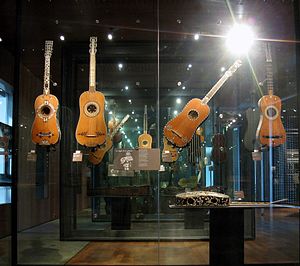 Baroque Guitars from the Museum Cité de la Musique in Paris (which houses almost 200 classical guitars[4])
Baroque Guitars from the Museum Cité de la Musique in Paris (which houses almost 200 classical guitars[4])
In general one can distinguish three main aspects of guitar making:
- "Sound" features
This includes everything from shaping of the wood (vibrational aspects: densities, stiffness); to wood-selection; to shaping of the bracing; to design; etc.
The aim is a quality of sound, that is defined by responsiveness, tonal depth, sustain, separation, dynamics, clarity, projection, evenness, balance, richness and timbre—all of which provide a palette of tone with which the music can be expressed and through which the music sounds better, more complex and more interesting.[5] Often there is also an aim of achieving a desired style of "sound aesthetic" (different styles of "sound aesthetic" can be distinguished e.g. when comparing instruments of Lacote or Grobert, with Torres, etc. - all can have high sound quality, yet one may be more appropriate for particular repertoire choices, e.g. Lacote or Grobert for "classical era repertoire" or "central European romantic repertoire"; versus Torres for "Spanish or late-romantic nationalist repertoire", etc.). - "Playability" aspects
This includes the shaping of the frets,[6] string-spacing, neck-width, neck, nut and bridge height (influence on action); decisions about scale-length; etc.
The aim is a guitar that is easy and comfortable to play, does not have string-buzz, and suits the requirements/desires of a particular player. - "Visual/decorative" aspects
This includes the visual features of the guitar, including rosette design, inlays, ornamentation, etc. (In general these creative visual aspects should not interfere or diminish the sound features, or hinder the playability of the guitar).
Fernando Sor has written that an instrument-maker "should be an accurate draughtsman, understand the common principles of mechanics, the composition and resolution of forces, and the laws of vibrating strings and surfaces".[7]
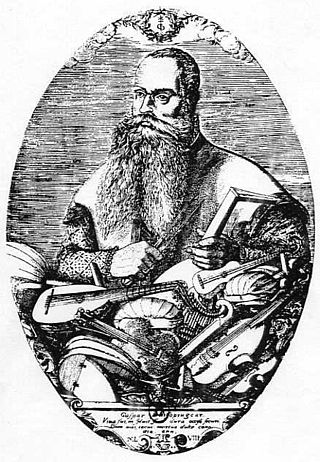 Gasparo Duiffopruggar (1514 - c. 1570) - Engraving by Pierre Woeiriot (1532-1599)
Gasparo Duiffopruggar (1514 - c. 1570) - Engraving by Pierre Woeiriot (1532-1599)
Viva fui in sylvis, sum dura occisa securi,
dum vixi, tacui, mortua dulce canoShaping of wood with acoustics and resonance aims
This shaping of the wood is known as "resonance plate tuning"[8] (or "plate tuning"). It refers to a comprehensive tuning of the wood and bracing (its density, thickness, tension, sound-influence) in order to influence the acoustic properties. (Contrary to the misunderstanding of numerous - even well-known - guitarmakers, it does not refer to a tuning of the guitar-body to a single "default" frequency. Instead, it is a comprehensive way of shaping the wood and thus its response and resonance properties, in order to improve the guitar's sound, when played.). The "tuning" of the wood is also known as the activity of "voicing" the instrument. Many consider this to be an art. The techniques used can be traced back the previous centuries, especially in violin-making (example: attempt at understanding some of the tuning schemes of Italian violins: 1, 2).
Some guitarmakers believe that the actual voicing of the wood, and working with and "shaping" the wood (during and even after construction) is more important than the outer construction itself (such as chosen bracing):
"As my skill and experience have grown I have come to believe that what makes a good guitar good is firstly how well fine tuned and balanced it is rather than what type of strutting system it is built with. Different strutting systems can add different flavours to the sound but is never the main factor in the Good Guitar.[9]" (Per Hallgren)Sound characteristics (Timbre)
Spectrum
One of the important aspects that good luthiers need to understand, is that a single tone consists of the "fundamental and simultaneous overtones".[10] (Historically the scientific analysis of this discovery can be associated with Nicole Oresme,[11] Marin Mersenne and Joseph Sauveur.) The ratio of the "intensity of fundamental" and the various overtones, defines the "colour" (Frequency spectrum) of the tone. Overtones are simply frequencies that are at a multiple of the base fundamental frequency. (Overtones defining colour, do not only occur in instruments, but also in the human voice. When singing a note, there are numerous overtones present. Singers experienced in overtone singing are able to control their voice in such a way, that they can increase the intensity of any high overtone to such an extent, that it becomes clearly audible, whilst simultaneously singing the fundamental. In this way two pitches (fundamental and high-intensity overtone) can be made clearly audible while singing.[12])
The colour of tones on a guitar are an important characteristic. Usually the notes of the guitar's different registers (low bass, mid range, high, etc.) will have different colour-spectrums, i.e. differing relative intensities of fundamental to different overtones.
Various types of guitars will have tone-differences of colour, in the various registers (also differences in response, action, etc.). Specific colour-spectrum characteristics of certain types of guitars can be said to form a specific "sound aesthetic" - this is like a "fingerprint" of the characteristic of that type of guitar. Other guitars will have a different "sound aesthetic", i.e. a different colour-spectrum characteristic.
One can associate historic instruments to various styles of "sound aesthetic".
Temporal change of spectrum (attack/onset, decay)
Important in characterizing the sound of instruments (or more precisely notes of particular registers), is the manner in which the sound begins: This is the attack or onset: a short-duration transient. This occurs at the moment when a string is plucked - the string builds up motion for some time, before it can vibrate in the normal way. The attack is nonlinear and usually has very high-pitched frequencies present. The duration of the transient (until normal string vibration continues) and frequencies occurring during the transient, are a very important factor in how we perceive the tone.
Once the string is in its normal mode of vibration, the standard colour-spectrum will be present. As time progresses the amplitude of the strings vibrations will get less, and usually the intensities of higher pitched overtones will decay at a faster rate, than the intensities of fundamental and lower overtones (thus a change of colour over the vibrating-time).
In this way one can observe the acoustic "envelope": the attack, followed by the way in which the intensity of frequencies (fundamental and overtones) decrease with time. The "envelope" can thus be regarded as the temporal change of the spectrum of the sound. This envelope will be different for notes in different registers.
Thus the tone or timbre is determined by:
- attack or onset (how long until normal vibration of the string? -> response of the guitar)
- relative intensities of frequency spectrum: fundamental to overtones (defines colour -> colour will change over vibrating time, since the higher-freq overtones decay quicker)
These factors can be influenced by the shaping of the wood. A good luthier understands how to shape the wood to directly influence these acoustic properties.
In guitar playing, the musician is actively able to vary the timbre (attack, colour-spectrum and its temporal change) in the way in which the string is plucked. The guitarist is able to change the position at which the string is plucked, and also the angle of the nail/finger to the string. A good instrument will give the musician the possibility of producing widely varying timbres and have yet have good resonance ("parts of the guitar body and wood boosting frequencies by moving in sympathy") over all notes.
Nevertheless a default colour and response is identifiable for notes in the different registers and define the instrument's sound aesthetic.
Styles of "sound aesthetic"
As was mentioned, it is possible to group historic instruments according to the colour and response sound characteristic (present for notes in the various registers). A baroque guitar will have a different "sound aesthetic" than a 19th century guitar, i.e. a differing colour-spectrum in the various registers (low, mid, high) and a different duration of attack (response of the instrument).
The "sound aesthetic" is determined by the sound characteristic of notes in specific registers (an instrument's low notes has a different relative timbre, than its high notes).
It is interesting to note the historical parallel between musical styles (baroque, classical, romantic, Spanish nationalist, flamenco, jazz) and the style of "sound aesthetic" of the musical instruments used: Robert de Visée played on a baroque guitar with a very different sound aesthetic than the guitars used by Mauro Giuliani or Luigi Legnani - they used 19th century guitars.
Whilst the difference between baroque guitars and 19th century guitars is large and immediately obvious, one can also identify differences in style within the 19th century guitars themselves: They are part of the same family, but one can distinguish early Italian instruments (Fabricatore), then French instruments and Viennese instruments, etc.[13]
Guitar making in the 19th century
To get a picture some of the ideas on guitar-building from the 19th century, it is interesting to list some newspaper reports of guitar-related patents (note that the newspaper reports given in the crossreferences are only brief mentionings, with the actual patent papers providing more details and drawings etc.) and other newspaper writings:
- Arzberger[14]
- Johann Georg Staufer and Johann Ertl[15][16][17]
- Bernhard Enzensperger[18]
- Franz Besetzny[19]
- Wenzel Soukup[20]
- Lacote, Carulli: Décacorde[21][22]
- J.F. Salomon: Harpolyre[23]
- Ventura: Harp Ventura (modification of harp and guitar)[24]
- etc.
There are also 19th century mentionings of Lacote winning a prize for the quality of his instrument - the second prize went to Laprevotte.[25] In the competition organized by Makaroff, it was the guitar of Scherzer that took first place.[26][27]
Guitars in the 19th century were initially all ladder-braced [28] and had their tonal energy spread over a lot of overtones (a desirable characteristic in instruments of the early classical and romantic era), as opposed to the more fundamental-rich guitars of Torres. Panormo and Páges were one of the first to experiment with fan-bracing, but it was not yet used as in the Torres guitar, so that Panormo and Páges still had a lot of tonal energy spread over overtones; which is different from the Torres guitars, which have the tonal energy more focused in the fundamental (desirable in Spanish music).
Movable frets
In order to perfectly solve all intonation problems of guitars; or allow guitarists to use a variety of different musical temperaments (or to play microtonal music) it is necessary for the frets on the guitar to be adjustable. Work in this field has already been done in the 19th century, when Thomas Perronet Thompson (1783–1869) wrote a work on the "Enharmonic Guitar",[29] with ideas which were used by Panormo.[30] Lacote also built a "guitare enharmonique"[31] with movable frets.
The luthier Walter J. Vogt (1935–1990) developed a contemporary mechanism with movable frets,[32][33] now also used by other luthiers e.g. Herve R. Chouard.[34] Tolgahan Cogulu has also designed an "adjustable microtonal guitar"[35] in 2008, based on Vogt's design.
Other concepts for changeable frets, include removable detachable fingerboards: "switchboards".[36][37][38]
See also: article "Just guitar" by John Schneider
Contemporary classical guitar making
The basis of most modern classical guitar designs was developed by Spanish luthier Antonio Torres Jurado in the mid 19th century. Earlier guitars were often smaller bodied (though there are exceptions: Scherzer, Guadagnini, etc.). Torres created a Spanish design, with light materials supported by fan bracing. Torres' fan bracing was influential for modern classical guitars: it consists of wooden strips glued inside the body to provide support and particular deep resonance that is saturated in fundamental.[39] (However, a type of fan bracing was already used before, in some guitars by the Spanish builder Joseph Páges, and after him Louis Panormo used a fan bracing too in some of his guitars from 1830–1850; but both Páges' and Panormo's guitars have a different sound aesthetic to Torres' guitars.) Torres used a string scale-length of 650 mm, which is usually the standard length for today's modern classical guitars.
The designs Torres developed were later adapted by several very influential luthiers; Manuel Ramirez (1864–1916) and his brother Jose Ramirez (1858–1923), Hermann Hauser Sr. (1882–1952) and Ignacio Fleta (1897–1977). Today, luthiers utilize the ideas and designs of Torres, Hauser, and Fleta in their own guitars. Some luthiers experiment with their own bracing, and some also offer cutaway, acoustic electric and composite top models.
For years, Brazilian Rosewood was the industry standard as the best wood for the backs and sides of guitars. Unfortunately, the export of Brazilian Rosewood has been restricted due to the endangerment of the species. Much of the Brazilian Rosewood used for guitars is of poor quality, and the inflated price of the wood has caused many luthiers to search for alternative tonewoods. There are many other good very dry woods for guitar construction. In fact, of the surviving Torres instruments, the most common back and side wood used was maple. Many guitars made today use East Indian Rosewood because it is a close substitute for Brazilian Rosewood, is readily available in high-quality, and has desirable characteristics as tonewood. There are many other woods with the characteristics to make excellent guitars and which are excellent alternatives: cocobolo, maple, bubinga (African Rosewood), African Blackwood, Camatillo Rosewood, Spanish Cypress (used exclusively for flamenco guitars), grandillo, ebony, satinwood, ziricote, among others, are excellent choices for backs and sides.
Contemporary Innovations
Lattice braced guitars
The Australian guitarmaker Greg Smallman introduced guitars with an extremely thin soundboard, which is supported by bracing in the shape of a lattice. Smallman combines this with heavier, laminated back and sides with a frame. Smallman is well-known for building the guitars played by John Williams. Other popular lattice braced classical guitar designs include the one by Roy Courtnall, which has been made in some numbers by guitar making students at the famous Newark School of Guitar Making.
Double-top, sandwich-top and composite-top
The terms double-top, sandwich-top, and composite-top all refer to a relatively new way to construct the soundboard of a guitar, developed by Matthias Dammann in Germany in the late 1980s. Other luthiers such as Robert Ruck, Fritz Mueller, Jim Redgate, Michel Bruck, Boguslaw Teryks and Gernot Wagner have since adopted the method. A double top usually consists of a material called Nomex sandwiched by two thin sheets of tonewood. A flame resistant meta-aramid material, Nomex was originally designed by DuPont Chemical Co. in the 1960s as a lightweight material for use in the aviation industry. Luthiers use the honeycomb sheet (calendered paper) version of the product: the low mass, strength, and ease of shaping make it ideally suited for guitar soundboards. Though the construction of a double top significantly differs from the traditional soundboard, a double top guitar often looks just like a traditional guitar.
Criticism of Lattice Bracing, Double Tops, etc.
While some people are positive towards innovations that directly affect a guitar's loudness; there are also a number of people who are critical of the tonal qualities of these guitars[40]
Lens Resonance System(R)
In 1999, Kauko Liikanen and Uwe Florath of Liikanen Guitars of Finland invented and patented the Lens Resonance System (LRS) of soundboard construction, for use principally on classical guitars.
The LRS soundboard is stiffened with a wooden cross-braced grid, under the bridge in the middle of the lower part of the soundboard. A thin plate of wood is glued under the grid. The cross-section of the whole construction is a lens shape and the soundboard around the bridge area is much stiffer and better controlled than it is in traditional soundboards.
Because the vibration energy produced by the strings is evenly distributed to the soundboard via the stiff middle area, a guitar with LRS sounds very responsive and it has an exceptional sustain. The resonance-curves of LRS soundboards are more even than they are in guitars with traditionally built soundboards and undesirable harmonics are reduced.
Side Soundport
A number of luthiers are now incorporating a soundport, an additional small soundhole on the guitar's side, usually facing the player. This is said to allow air to move more freely in and out of the body of the guitar as it is vibrating, and to have the advantage of allowing the player to better hear the sound projecting from the guitar. The only published formal research on the latter subject suggests however that players may not be able to hear any difference in a soundport equipped guitar.[41]
Finger board
Improvement of intonation and playability.
Elevated fingerboard
Some guitar makers like American Thomas Humphrey (who patented such a system in US patent 4,873,909),Italian guitarmaker Renato Barone Frenchman Antoine Pappalardo and the Canadian Fritz Mueller make Elevated fingerboard guitars. The primary advantage is to improve left hand playability on the upper frets, although the increased distance between the strings and the top is also advantageous for the right hand. The elevated fingerboard is visually unobtrusive from the front, and the instrument retains its traditional appearance.
Curved fingerboard
Some guitar makers like the French Antoine Pappalardo make a Curved fingerboard to improve the playability.
High frets
High frets facilitate vibrato and barreing, and generally aid in the development of a "lighter" left hand.
Multiple scale length fretboards
The 17th century wire strung instruments, Orpharion and Bandora are early examples of instruments featuring multiple scale fretboards.
Armrest
An armrest provides three primary benefits: it lessens damping of the top caused by the right forearm; it is potentially more comfortable for the player; and it absorbs the wear to the finish that would otherwise happen on the top, the binding, and the side. These benefits are of particular importance for ultra-thin-topped instruments, such as Smallman's, but could subtly improve any guitar, including double-tops.
The state of classical guitar making – outlook and retrospective
While most classical guitar makers are today mainly concerned with making modern classical guitars with their typical fan-bracing or experimenting to make the instrument louder (e.g. "thin-top lattice-braced", "double-top", with results that are not without criticism[40]); they seem to give little consideration to historical sound ideals, or to tuning and voicing of the parts of the instrument.[43]
On the other hand, there are opinions that those guitar makers who openly refer to using plate tuning, may be using it more as a marketing gimmick, than something that they truly understand; and which has a marked influence on the instruments sound.
- "[...] my building technique doesn't include "component tuning." My experience of thirty five years has led me to the conclusion that "tuning" the sound of a guitar is an illusion and a chimera, and those who publicly advocate that they can accurately control the response of a guitar by responding to noises derived from tapping parts of it, are simply seducing the innocent, or at best, self-deluded." (William R. Cumpiano on "Tap Tuning"[44])
And yet: plate tuning (voicing the instrument) is a significant part of violin-making culture - recently considerable advances have been made in the voicing of violins, so that modern violins by some makers are finally beginning to compete tonally with the best violins of the past (Stradivari, Guarneri, Amati...). In fact, top violinists who traditionally played Stradivari, are now slowly beginning to use modern violins (this was rather uncommon up till recently).[45][46][47] It is well known that just making an exact copy, will not result in a instrument which has the desirable qualities of the original. In contemporary top-level violin-making culture, the actual voicing of the instrument, may even take more time than the construction:
- "Even when exact copies of Stradivari are made, the sound of the copy differs considerably with the original. This experience shows us, that the most significant part of our work is the tuning of the corpus of the violin, which often takes more time than the mere construction." (Stefan-Peter Greiner[48])
In this respect (and considerations of sound aesthetic), guitar making is today still considered to be lagging far behind professional violin-making.
In violin culture many good old master-violins have been analyzed for their sound qualities (e.g. Stradivari, or Guarneri are favoured by many people; though some consider these instruments as too "outwardly" loud, yet lacking the "inner" tonal qualities of say Amati). Analysis of measurements have shown:
- "[...]overtones of an old Italian master instrument are equivalent to the overtones of the vocally sung vowels "e" and "i". These lie between 2000 and 4000 hertz, in a frequency range in which the human ear is most sensitive. The violin sound is therefore most likely described through and compared with the ideal of Italian belcanto."[48]
Some old italian master-violins, that were analyzed, had a spectral resonance peak (amongst others!) at around 2800 Hz,[49] which is also known as the singer's formant: This is an increase in energy at around 2800 Hz which allows singers to be clearly heard over a loud orchestra, and will give the violin a similar "presence". To what extent these observations can also be used in guitar-making is an interesting open question.[says who?]
In guitar making, it is more difficult to find similarly idealized instruments (in this case guitars), for a number of reasons:
- There are not many guitars still in existence, from the period that some people[who?] consider the "Golden Age of Acoustics or instrument making" (17th and 18th centuries); e.g. there are only five guitars from Stradivari still known to exist[51][52][53] and luthiers and players are unlikely to have even heard them, in order to judge their tonal quality.
- As can be seen from violin making, there was a decrease in luthiers' tonal quality in the 19th century, when compared to the "Golden Age" (some people attribute this to luthiers' greater focus on the visible aspects, as opposed to the sound itself[54]). Also, in this time, the guitar went through many different outer shapes, and luthiers also had to cater for guitar demands from many amateurs at the time;[55] so ultimately, for any given instrument from about 1800 to 1900, it could be one of high tonal quality, but might just as well be a mediocre instrument; or one with a design and tonal characteristic, that was later abandoned by the maker (though there are 19th century guitar-makers such as Lacote and Scherzer, who are generally considered as having built guitars with high tonal quality).
- Most guitars today are still built using Spanish Torres or post-Torres fan-bracing. This has become the de facto classical guitar instrument today, but while being suitable for most modern Spanish repertoire, it is rather unsuitable for much of the earlier repertoire from the baroque, classical and romantic era. Neither guitarists, nor luthiers have a lot of knowledge on earlier design idioms, or sound aesthetics; though this is improving with an increasing interest in historically informed performance; and luthiers who do not only limit themselves and their interests to guitars (but also consider violin-making culture, lute-making culture (ladder-bracing!) and draw parallels).
The de facto standard classical guitar today is the Spanish guitar: usually fan-braced and strong in fundamental.[says who?] While fan-braced Spanish (Torres, post-Torres style) instruments coexisted with traditional central European ladder-braced (19th century style) guitars at the beginning of the 20th century, the central European guitars eventually fell away. Some[who?] attribute this to the popularity of Segovia, considering him "the catalyst for change toward the Spanish design and the so-called 'modern' school in the 1920's and beyond".[56] The styles of music performed on ladder-braced guitars, were becoming more and more unfashionable; and e.g. in Germany musicians were in part turning towards folk-style music (Schrammel-music and the Contraguitar), which only remained localized in Germany, etc. On the other hand, Segovia was concertizing around the world popularizing his Spanish guitar, as well as a new style of music in the 1920s: Spanish romantic-modern style, with guitar works by Moreno Torroba, de Falla, etc.
In fact, Segovia's Santos Hernandez (Ramirez) guitar from 1912, has a slightly different sound aesthetic, than the earlier Torres design.[57] While the Torres is a guitar[57] that some consider more appropriate to the salon style music of Tarrega, Arcas or Llobet (or arrangements of Granados, Albeniz), the later romantic-modern style of Moreno Torroba (whom Segovia met in 1918), Castelnuovo-Tedesco (whom Segovia met in 1932), etc. - combined with requirements of performing in large concert halls - was uniquely suited to Segovia's performance on the Santos Hernandez and later on the numerous Hauser guitars (1929, 1931, 1937, etc.)[58] that he owned.
Yet "Andres Segovia presented the Spanish guitar as a versatile model for all playing styles",[56] to the extent that still today, "many guitarists have tunnel-vision to the world of guitar, coming from the modern Segovia tradition of revisionism".[59] Torres and post-Torres style modern guitars with their fan-bracing, have a thick and strong tone: but they are considered too saturated in fundamental, as to be appropriate to earlier repertoire (Classical/Romantic: Carulli, Sor, Giuliani, Mertz, ...; Baroque: de Visee, ...; etc.).
Torres and post-Torres guitars have a strong thick sound, which is not to be confused with rich overtones, since these guitars are rather saturated in fundamental.
- "With the change of music a stronger fundamental was demanded and the fan bracing system was approached. [...] the guitar tone has been changed from a transparent tone, rich in higher partials to a more "broad" tone with a strong fundamental."[60]
The sound aesthetic of early romantic guitars (such as Lacote) on the other hand, has stronger overtones (yet without being starved in fundamental - which would again be undesirable). This stronger overtone presence is due to the ladder-bracing and soundboard design, and the particular voicing of the instrument. A comparison with lutes (ladder bracing) can be made, which also have strong overtones, which gives these instruments (lutes, early romantic guitars) a type of "inner" vulnerability, lacking in the modern guitars.[citation needed] (In fact there are people[who?] who claim that a performer's interpretational style is psychologically related with the instrument's aesthetic; and that this can even be observed in contemporary recordings, e.g. Bach's lute works as performed on lute[61](with convincing expressive phrasing), versus the markedly different interpretations of these works on the modern classical guitar.[62] Alternately, the Spanish repertoire such as Moreno Torroba, would be completely unfitting, for a lute or early-guitar sound aesthetic.)
Even amongst parlor guitar players, there are some that consider ladder bracing necessary, for achieving the desired "old-time sound".[63]
With an increase in interest in historically informed interpretation, there are more and more luthiers that are beginning to look at traditions of guitar building.[citation needed]
The guitar makers that are creating guitars in the style of the 19th century or earlier are often so concerned with creating exact copies (copying everything that they can see; even up to the style of the engravings, tuning pegs etc.), that often the tonal characteristics fall short.[citation needed] (There exists a parallel in musical performance, where early music performers today are often so concerned with the notated written notes - believing that it leads to the composer's intentions and authenticity - that they achieve the opposite: performed music which is stale, uninspired, regular and lacking in communicative expression.[64]) Othertimes (particularly for 19th century guitars), the instruments which luthiers choose to copy, are substandard instruments, from the outset, that have little in common with the instruments that 19th century virtuosos actually played.[55] Either way, the resulting mediocre copies, are often being sold with the argumentations of being "authentic", having the appropriate tonal "sound aesthetic", and being "suitable to such and such repertoire".
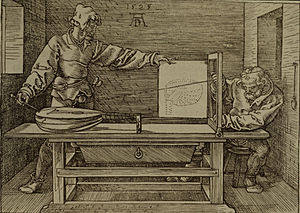 Man drawing a lute by Albrecht Dürer (1471–1528)
Man drawing a lute by Albrecht Dürer (1471–1528)
Today there are some luthiers that suggest building these historic instruments, based not only on outer visual details, but rather, based on acoustic principles from the master luthiers of the 17th and 18th centuries, leaning towards and learning from the great makers (Stradivari, Amati, Ruckers, etc.).[65] Drawing a parallel to violin-making culture, and lutherie as a broader art, it might be interesting[says who?] to deriving indications for the possible aims and ideals of "sound aesthetic in guitars" from other instruments (e.g. of the "Golden Age of Acoustics"), which would open up the possibility of tonally competing[46][48] with luthiers from earlier periods, instead of only visually imitating and copying them.[66]
See also
References
- ^ Grobert guitar from Le Musée du Conservatoire national de musique by Gustave Chouquet
- ^ Grobert guitar - brief details
- ^ Grobert guitar from The guitar and mandolin : biographies of celebrated players and composers for these instruments by Philip James Bone
- ^ a b Cité de la Musique: Les guitares classiques du Musée de la musique (almost 200 classical guitars); Catalog: Instruments et oeuvres d'art - use search-phrase: Mot-clé(s) : guitare
- ^ Ervin Somogyi: The State of the Contemporary Guitar
- ^ Fernandez "Custom Set-up" for frets, etc.; video demonstration
- ^ Fernando Sor. "Méthode pour la Guitare". Tecla. http://www.tecla.com/catalog/0389.htm.
- ^ Die Theorie der harmonischen Abstimmung der Resonanzplatten bei der Geige ... (1907) by Max Grossmann (Grossmann's text should not be interpreted as the only way to do plate tuning. They simply represent Grossmann's own theories - which were used by luthier Otto Seifert from c. 1904 - c. 1914)
- ^ Per Hallgren
- ^ Modes, Overtones and Harmonics - Chapter 3 from The Physics of Music and Musical Instruments by David Lapp
- ^ Nicole Oresme
- ^ Overtone singing, Frequency Spectrum of the voice, showing the fundamental and various overtones: octave, ..., and high-intensity higher overtones (a melody is created, by shifting the intensity to various overtones, while others are more suppressed)
- ^ As an example: Viennese guitars usually have more fundamental in the tone (but less, than with Torres fan-bracing), while the earlier French models have more overtones
- ^ Vorschlag zu einer wesentlichen Verbesserung im Bau der Guitarre. AMZ XI, page 481–8. 1809. http://books.google.com/?id=R98qAAAAYAAJ&pg=PA482.
- ^ "Jahrbücher des kaiserlichen königlichen polytechnischen Institutes in Wien, 4. Band". 1823. http://www.archive.org/stream/jahrbcher11wiengoog#page/n602/mode/1up.
- ^ "Jahrbücher des kaiserlichen königlichen polytechnischen Institutes in Wien, 13. Band". 1828. http://www.archive.org/stream/jahrbcher15wiengoog#page/n400/mode/1up.
- ^ 1
- ^ "Jahrbücher des kaiserlichen königlichen polytechnischen Institutes in Wien, 17. Band". 1832. http://www.archive.org/stream/jahrbcher08wiengoog#page/n391/mode/1up.
- ^ Wien, Kaiserliches köNigliches Polytechnisches Institut in; Wien, Technische Hochschule (1825). Jahrbücher des kaiserlichen königlichen polytechnischen Institutes in Wien, 7. Band. http://books.google.com/?id=mAwOAAAAQAAJ&pg=RA2-PA354&dq=Franz.
- ^ Wien, Technische Hochschule (1837). Jahrbücher des kaiserlichen königlichen polytechnischen Institutes in Wien, 19. Band. http://books.google.com/?id=sXCR3xtbFzIC&pg=RA1-PA450&dq=Guitarrenmacher.
- ^ Molard, Claude Pierre (1832). Description des machines et procédés spécifiés dans les brevets d'invention. http://books.google.com/?id=ckUFAAAAQAAJ&pg=PA258&dq=lacote+guitare.
- ^ Digler, Johann Gottfried (1835). Polytechnisches Journal, Volume 48. http://books.google.com/?id=stUPAAAAQAAJ&pg=PA283&dq=lacote.
- ^ The Harmonicon. 1828. http://books.google.com/?id=vV0PAAAAYAAJ&pg=RA1-PA300&dq=salomo.
- ^ Arcana of Science and Arts. 1831. http://books.google.com/?id=jCMFAAAAQAAJ&pg=PA24&dq=ventura.
- ^ Rapport du Jury central. 1844. http://books.google.com/?id=B5hBAAAAIAAJ&pg=PA557&dq=LACOTE+guitare.
- ^ Le Guide musical: revue internationale de la musique. 1856. http://books.google.com/?id=zNk8AAAAMAAJ&pg=RA1-PT69&dq=Scuf.rzeb.
- ^ Gazette musicale de Paris, Volume 24. 1857. http://books.google.com/?id=HO8sAAAAYAAJ&pg=PA16-IA6&dq=guitaristes+Scherzer.
- ^ Examples of ladder-bracing:
1828 Lacote, A. Stauffer & Comp., ca. 1825, Lavigne, Paris circa 1815, (Pons-style Y-Bracing) (ref)
Fabricatore
Stauffer guitar from about 1836 (ref)
Early 6-string guitar from about 1780: 1, 2, 3, 4, 5 (ref)
Nicolas Bonafon around 1840 (ref) - ^ Instructions to my daughter for playing on the enharmonic guitar: an attempt to effect the execution of correct harmony, on principles analogous to those of the ancient enharmonic by Thomas Perronet Thompson (1783-1869)
image Review (The Harmonicon, 1830) Excerpt on temperament (The Harmonicon, 1830) Extended Review (The Westminster Review, Volume XVI, 1832) - ^ Louis Panormo, "Enharmonic Guitar", London 1829
- ^ Lacote: Guitare Enharmonique (E.1043 Cite de la musique) photo1 photo2 ref "An enharmonic guitar by René François Lacôte, Paris, ca. 1850"; Description & Restoration Report: Ian Watchorn, Melbourne, 1990.
- ^ Walter J. Vogt: Patent on movable frets (original german (establ. session, then reload link))
earlier and other patents - ^ Movable frets of a Walter Vogt guitar
- ^ Herve R. Chouard: movable frets images images video - see from 3:18 to 3:49
- ^ "Adjustable microtonal guitar" by Tolgahan Cogulu
- ^ Patent: Fretted musical instrument with detachable fingerboard by Thomas D. Stone
- ^ Switchboards and Vogt System of movable frets
- ^ Detachable fingerboard image
- ^ fundamental as opposed to overtone
- ^ a b Traditional versus modern construction of soundboards by Sebastian Stenzel
- ^ Mottola, R.M. (Winter 2008). "Blind Listening Evaluation of Classical Guitar Soundports". American Lutherie (96): 54.
- ^ Jost Amman: Der Lautenmacher - The Lute Maker by Kenneth Sparr
- ^ Example: José Romanillos (although he acknowledges that plate tuning may provide benefits: "a field to think about") looks upon plate tuning rather critically and - as can be seen from a video - he neither understands it (this can be deduced from his rather confused presentation, and strong difference when compared with Somogyi's presentation), nor does he use plate tuning in his own guitars.
- ^ William R. Cumpiano on "Tap Tuning"
- ^ Debunking the Stradivarius myth by Geoffrey Norris; 10 Feb 2005; telegraph.co.uk
- ^ a b In Direct Competition with Stradivari July 2006; goethe.de
- ^ see last 4 paragraphs: A Violin's Value, and What to Pay the I.R.S. Fiddler By Richard Lezin Jones; 2 May 2004; NY Times
- ^ a b c Idea of Sound - Measuring the Old Italian Violins - A Vowel Tone
- ^ Neuere Klanguntersuchungen an Geigen und ihre Beziehung zum Gesang [1]
- ^ Athanasius Kircher: Page 477 (alternative) from Musurgia universalis sive ars magna consoni et dissoni - Tome 1 Athanasius Kircher (1602-1680)
- ^ The Sabionari Guitar, made in Cremona in 1679
- ^ The Rawlins Stradivari Guitar, 1700 (National Music Museum; University of South Dakota)
- ^ Guitar by A Stradivari (Ashmolean Museum)
- ^ Interview with Keith Hill; original: Building Sound (3 Quarks Daily)
- ^ a b Fernando Sor notes: "This skillfull artist [Lacote] is very frequently obliged to satisfy those who consider the instrument otherwise than I do, and make guitars on which it is impossible to play my music or any other that has the base and other parts of the harmony always proceeding correctly; but let a good instrument be ordered of him, leaving him at liberty to make it as he pleases, he will make one for me [...]" (Fernando Sor. "Méthode pour la Guitare". Tecla.)
- ^ a b Early Classical Guitar and Early Romantic Guitar Time Period by earlyromanticguitar.com
- ^ a b note in particular that Torres also built guitars that have a smaller body than todays modern classical guitars
- ^ Hauser: 126 Years Of Manufacturing Guitars And Musical Instruments In Bavaria
- ^ Early Romantic Guitar Period Technique by earlyromanticguitar.com
- ^ Function, Construction and Quality of the Guitar; 1983
- ^ Timothy Burris, Hopkinson Smith, etc.
- ^ John Williams (guitarist), Stephan Schmidt, etc.
- ^ Ladder-braced Guitars and the Enduring Mysteries of the Old-Time Sound by Dan Margolies
- ^ "Text and Act, by Richard Taruskin (discussion)". http://www.bach-cantatas.com/Books/Book-Text&Act%5BTaruskin%5D.htm.
- ^ Acoustical Technology Training by Keith Hill
- ^ and – for 19th century instruments - some of their substandard instruments, or instruments made for amateurs (see the Sor comment above)
External links
- The Guitar Family Tree by Dennis Cinelli
- (French) A wiki on classical guitar making
 Classical guitar portal
Classical guitar portalMain articles - Classical guitar
- History of the classical guitar
- Early classical guitar recordings
- Classical guitar technique
- Classical guitar repertoire
- Classical guitar strings
- Classical guitar making
- Classical guitar pedagogy
Related instruments - Brahms guitar
- Extended-range classical guitar
- Harp guitar
- Lyre-guitar
- Six-string alto guitar
Early guitars - Gittern
- Vihuela
- Baroque guitar
- Early romantic guitar
Classical guitar lists - Guitar main article
- Luthier main article
- Classical guitar WikiProject
Categories:- Classical guitar
- Lutherie
- "Sound" features
Wikimedia Foundation. 2010.

